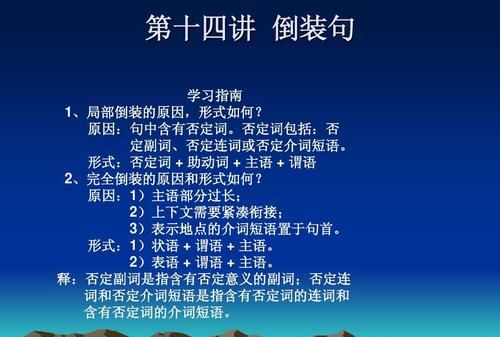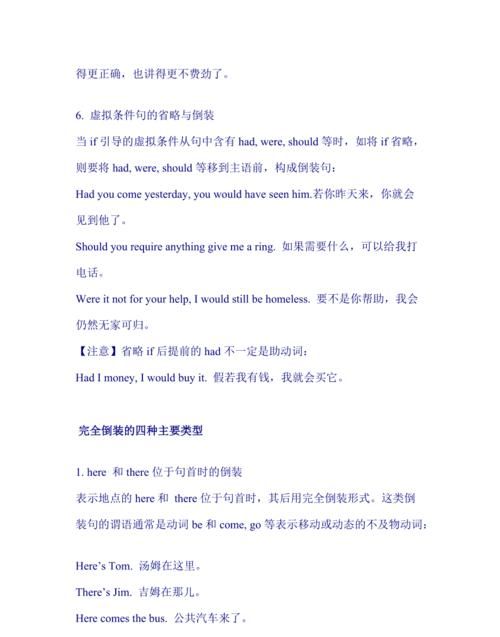本文目录
英语倒装句的结构是什么
倒装语序分为全部倒装和部分倒装,全部倒装结构是谓语动词提前至主语之前,部分倒装结构是助动词或情态动词提至主语之前,而谓语动词位置不变。
具有“地点”意义的副词、时间意义的副词,以及能表移动方向的副词放在句首,句子的主语是名词,谓语是连系动词或表示“位置移动”的单个不及物动词时,该动词放在主语前面。
具有“方位”意义的介词短语或副词短语在句中作状语或表语放在句首,谓语是连系动词be,以及表示“位于、存在”或“位置移动”的单个不及物动词时,该动词放在主语前面。

一、全部倒装:
谓语动词提前至主语之前为全部倒装。
1、当首句为方位或时间副词,谓语动词为go,come等时通常用全部倒装。
2、如果句首出现了地点状语,句子也可以进行全部倒装。
3、当句子中出现分词结构的时候,可以把现在分词或过去分词和地点状语联系在一起放在句首,把be动词留在中间当作谓语动词,主语放在后面。
二、部分倒装:
助动词或情态动词提至主语之前,谓语动词位置不变,即为部分倒装。
1、当句首状语为否定词或带有否定意义的词语时,这个句子就需要部分倒装。
2、当句首为only加状语的时候,这个句子需要部分倒装。
3、so.....that结构中的so位于句首时,常引起部分倒装。
4、句子开头的as处在第二个单词的位置上,表示虽然的意思时,用部分倒装。
5、常见的固定搭配结构中需要用倒装的情况。
英语当中的倒装如何理解呢
倒装(Inversion)是一种语法手段,用以表示一定句子结构的需要和强调某一句子
成分的需要.英语的最基本结构是主、谓结构,倒装就是将这种比较固定的结构
加以颠倒.
倒装有两种:将主语和谓语完全颠倒过来,叫做完全倒装(Complete
Inversion).如:In came a man with a white beard.
只将助动词(包括情态动词)移至主语之前,叫做部分倒装(Partial
Inversion).如:Only once was John late to class.
英语句子的倒装一是由于语法结构的需要而进行的倒装,二是由于修辞的需
要而进行的倒装.前一种情况,倒装是必须的,否则就会出现语法错误;后一种情
况,倒装是选择性的,倒装与否只会产生表达效果上的差异.下面本文就拟从其修
辞功能谈谈倒装句的用法.
一、 表示强调:
倒装句最突出、最常见的修辞效果就是强调,其表现形式如下:
1. only +状语或状语从句置于句首,句子用部分倒装.
例1:Only in this way can you solve this problem. 只有用这种方法,你
才可以解决这个问题.
例2:Only after he had spoken out the word did he realize he had
made a big mistake.只有当他已经说出那个字后才意识到自己犯了个大错误.
2. not,little,hardly,scarcely,no more,no longer,in no
way,never,seldom,not only,no sooner等具有否定意义的词或词组位于句首,句
子用部分倒装.
例1: No sooner had I got home than it began to rain. 我刚到家就下
起了雨.
例2: Seldom do I go to work by bus. 我很少乘公共汽车上班.
3. so / such...that结构中的so或such位于句首可以构成部分倒装句,表示
强调so /such和that之间的部分.
例1:So unreasonable was his price that everybody startled. 他的要
价太离谱,令每个人都瞠目结舌.
例2:To such length did she go in rehearsal that the two actors
walked out. 她的彩排进行得那么长,以致于那两个演员都走出去了.
以上各例都用倒装语序突出了句首成分,其语气较自然语序强烈,因而具有极
佳的修辞效果.
二、 承上启下
有时倒装可把前一句说到的人或物,或与前一句有联系的人或物在下一句紧
接着先说出来,从而使前后两句在意思上的关系更加清楚,衔接更加紧密,起到承
上启下的作用.
例1: They broke into her uncle's bedroom and found the man lying
on the floor, dead. Around his head was a brown snake. 他们破门进入她
叔叔的卧室,发现他躺在地板上死了.一条棕褐色的蛇缠在他头上.
例2: We really should not resent being called paupers. Paupers we
are, and paupers we shall remain. 我们确实不应因为被称作穷光蛋而愤愤不
平.我们的确是穷光蛋,而且还会继续是穷光蛋.
三、 制造悬念,渲染气氛
在新闻或文学创作中,有时为了内容的需要,或是为了强调,作者常常运用倒
装来制造悬念,渲染气氛.如:
Hanging on the wall was a splendid painting. 墙上挂着一幅精美的图
画.
再如朗费罗(Longfellow)《雪花》中的一节:
Out of the bosom of the Air,
Out of the cloud-folds of her garments shaken,
Over the woodlands brown and bare,
Over the harvest-fields forsaken,
Silent, and soft, and slow,
Descends the snow.
在这一节诗里 ,诗人就富有创意地运用了倒装.在前五行中 ,诗人堆砌了七
个状语,状语连续出现而主语和谓语却迟迟未露 ,造成一种悬念效应.全节读
罢 ,读者才对诗歌的主题恍然大悟 ,因而收到了不同凡响的艺术效果.
四、 平衡结构
英语修辞的一个重要原则是尾重原则,即把句子最复杂的成分放在句尾以保
持句子平衡.在语言使用中为了避免产生头重脚轻、结构不平衡的句子,我们常
采用倒装语序.
1. 以作状语的介词短语开头:当主语较长或主语所带修饰语较长时,为了使
句子平衡,常将状语置于句首,句子用完全倒装语序.
例1:A. To the coal mine came a com-pany of PLA soldiers with
orders from the headquarters to rescue the trapped miners.
B. A company of PLA soldiers came to the coal mine with orders
from the headquarters to rescue the trapped miners.
一个连队的解放军战士来到了那座煤矿,奉司令部之命解救受困的矿工.
例2:A. On the ground lay some air conditioners, which are to be
shipped to some other cities.
B. Some air conditioners lay on the ground, which are to be
shipped to some other cities.
地上放着一些空调,等着用船运到其他城市去.
从例句中可看出, 采用倒装语序的A句结构平衡稳妥 ,读起来自然流畅,而采
用自然语序的B句结构零乱, 读起来也别扭.因而,在主语较长时就应采用倒装语
序以取得理想的表达效果.
2. 以表语开头的句子:有时为了把较长的主语放在后面,须将表语和谓语都
提到主语前.如:
Such would be our home in the future. 我们将来的家就是这个样子.
3. 以副词here , there开头的句子,也采用完全倒装来保持句子平衡.如:
Here is the letter you have been looking forward to. 你盼望已久的
信在这儿.
五、 使描写生动
有时为了使叙述或描绘更加生动形象,增加语言效果,可将表示方向的副词
(如:down, up, out, in, off, on, away等)或拟声词(bang, crack等)置于句
首,句子采用全部倒装的语序(主语为人称代词的句子除外).如:
Up went the rocket into the air. 嗖地一声火箭就飞上天了.
Down jumped the criminal from the third floor when the policeman
pointed his pistol at him. 当警察把手枪瞄准那个罪犯时,嘭地一下他就从三
楼跳了下去.
Boom went the cannon! 轰隆一声大炮开火了!
Bang came another shot!砰!又是一声枪响!
以上句子简洁明快 ,生动逼真地描述了有关动作 ,令我们一览此类倒装的风
采.但这种倒装句的修辞功能在语段中可以体现得更为清楚.
“Stop thief! Stop thief!” There is a magic cry in the sound.
The tradesman leaves his counter, ... Away they run, pell—mell,
helter—skelter, yelling—screaming, ...
“Stop thief ! Stop thief !” The cry is taking by a hundred
voices, ... Away they fly, splashing through the mud, up go the
window, out run the people. ( Dickens )
作者在第一段和第二段中分别用副词away, up和out位于句首引出四个倒装
句Away they run , Away they fly, up go the window , out run the
people.从而制造出一种紧张、急促的气氛 ,生动地刻画了一个紧张、混乱的捉贼场面.

英语倒装句12种类型及例句初中
英语倒装句12种类型:
1、“there be”结构 在这一结构里,there是引导词,主语在be后。
There is a box on the table. 桌子上有个盒子。
2、疑问句 疑问句为倒装形式。
Is she singing in the classroom? 她是不是正在教室里唱歌?
3、here、there等副词开头的句子(部分)
在here、there等副词开头的某些句子中(要用一般现在时态)(前两个例句);如果主语是人称代词,主语和主要动词的词序不变。(完全倒装)(最后一个例句)
There goes the bell. 铃响了。
4、重复倒装句型
在以so、nor、neither开头,表示谓语所述的情况也适用于另一个人或一事物的肯定或否定句中。so用于肯定句,表示“也一样”、“也这样”;nor、neither用于否定句,表示“同样也不,也不这样”。
I am watching TV. So is she. 我在看电视,她也是。
5、直接引语的全部或一部分放在句首时,主句中的主谓也常直接倒装(完全倒装)
"Very well," said the French student. “很好”,那个法国学生说道。
6、否定副词开头的句子(部分倒装)
在以never、little、hardly、not
only、few、not、seldom等否定副词开头的句子中,采用部分倒装;如果不放在句首就不要倒装。
Little did he say at the meeting.在会上他没说话。

7、以only所修饰的副词、介词短语或状语从句的句子
Only when the war was over in 1918 was he able to get happily back to work. 只有1918年战争结束,他才能开心地重归工作。
8、地点、方位副词在句首 (完全倒装)
为了表达生动,有时把表地点、方位的副词,如
up、down、out、away、in等放在句首,同时把谓语动词放在主语之前。若主语为人称代词,主语和谓语动词的位置不变,只将副词放在句首。(完全倒装)
Away hurried the boy. 男孩匆忙走开了。
9、虚拟结构中
在虚拟结构中,条件从句的谓语含有were、had 和should这三个词是,可省去if,将这些词移至主语之前。
Had I time (= If I had time), I would go and help you. 如果我有时间,我会去帮助你的。
10、as 引导的让步状语从句
as引导让步状语从句时要倒装(形容词/ 副词/ 名词/ 动词 + as + 主语 + 谓语)。
Proud as they are, they are afraid to see me. 他们很傲慢,但是也害怕看到我。
11、祝愿的句子
用于某些表示祝愿的句子里。
May you succeed! 祝你成功!
12、So + 形容词、副词及such 置于句首时
So happy did he feel. 他感觉非常开心。
英语倒装句怎么写
英语倒装句怎么写
1)On the wall hangs a picture.
2)Here es the bus.
3)Only in this way can you improve your English.
4)Not until he graduated did he realise he had wasted much time.
5)So shallow is the river that no fish can live in it.
6)Had I known it sooner,I would have e here.
英语倒装句怎么写最好写写倒装句的例句
倒装有两种:
将主语和谓语完全颠倒过来,叫做完全倒装(Complete Inversion)。如:In came a man with a white beard.
只将助动词(包括情态动词)移至主语之前,叫做部分倒装(Partial Inversion)。如:Only once was John late to class.
英语句子的倒装一是由于语法结构的需要而进行的倒装,二是由于修辞的需要而进行的倒装。前一种情况,倒装是必须的,否则就会出现语法错误;后一种情况,倒装是选择性的,倒装与否只会产生表达效果上的差异。下面本文就拟从其修辞功能谈谈倒装句的用法。
一、 表示强调:
倒装句最突出、最常见的修辞效果就是强调,其表现形式如下:
1. only +状语或状语从句置于句首,句子用部分倒装。
eg.Only in this way can you solve this problem. 只有用这种方法,你才可以解决这个问题。
eg.Only after he had spoken out the word did he realize he had made a big mistake.只有当他已经说出那个字后才意识到自己犯了个大错误。
2. not, little, hardly, scarcely, no more, no longer, in no way, never, seldom, not only, no sooner等具有否定意义的词或片语位于句首,句子用部分倒装。
eg. No sooner had I got home than it beg.an to rain. 我刚到家就下起了雨。
eg. Seldom do I go to work by bus. 我很少乘公共汽车上班。
3. so / such...that结构中的so或such位于句首可以构成部分倒装句,表示强调so /such和that之间的部分。
eg.So unreasonable was his price that everybody startled. 他的要价太离谱,令每个人都瞠目结舌。
eg.To such length did she go in rehearsal that the o actors walked out. 她的彩排进行得那么长,以致于那两个演员都走出去了。
以上各例子都用倒装语序突出了句首成分,其语气较自然语序强烈,因而具有极佳的修辞效果。
二、 承上启下
有时倒装可把前一句说到的人或物,或与前一句有联络的人或物在下一句紧接着先说出来,从而使前后两句在意思上的关系更加清楚,衔接更加紧密,起到承上启下的作用。
eg.They broke into her uncle's bedroom and found the man lying on the floor, dead. Around his head was a brown snake. 他们破门进入她叔叔的卧室,发现他躺在地板上死了。一条棕褐色的蛇缠在他头上。
eg. We really should not resent being called paupers. Paupers we are, and paupers we shall remain. 我们确实不应因为被称作穷光蛋而愤愤不平。我们的确是穷光蛋,而且还会继续是穷光蛋。
三、 制造悬念,渲染气氛
在新闻或文学创作中,有时为了内容的需要,或是为了强调,作者常常运用倒装来制造悬念,渲染气氛。如:
Hanging on the wall was a splendid painting. 墙上挂著一幅精美的图画。
再如朗费罗(Longfellow)《雪花》中的一节:
Out of the bosom of the Air,
Out of the cloud-folds of her garments shaken,
Over the woodlands brown and bare,
Over the harvest-fields forsaken,
Silent, and soft, and slow,
Descends the snow.
在这一节诗里 ,诗人就富有创意地运用了倒装。在前五行中 ,诗人堆砌了七个状语,状语连续出现而主语和谓语却迟迟未露 ,造成一种悬念效应。全节读罢 ,读者才对诗歌的主题恍然大悟 ,因而收到了不同凡响的艺术效果。
四、 平衡结构
英语修辞的一个重要原则是尾重原则,即把句子最复杂的成分放在句尾以保持句子平衡。在语言使用中为了避免产生头重脚轻、结构不平衡的句子,我们常采用倒装语序。
1. 以作状语的介词短语开头:当主语较长或主语所带修饰语较长时,为了使句子平衡,常将状语置于句首,句子用完全倒装语序。
eg.To the coal mine came a -pany of PLA soldiers with orders from the headquarters to rescue the trapped miners.
eg.A pany of PLA soldiers came to the coal mine with orders from the headquarters to rescue the trapped miners.
一个连队的解放军战士来到了那座煤矿,奉司令部之命解救受困的矿工。
eg.On the ground lay some air conditioners, which are to be shipped to some other cities.
eg.Some air conditioners lay on the ground, which are to be shipped to some other cities.
地上放著一些空调,等著用船运到其他城市去。
从例句中可看出, 采用倒装语序的A句结构平衡稳妥 ,读起来自然流畅,而采用自然语序的B句结构零乱, 读起来也别扭。因而,在主语较长时就应采用倒装语序以取得理想的表达效果。
2. 以表语开头的句子:有时为了把较长的主语放在后面,须将表语和谓语都提到主语前。
eg.Such would be our home in the future. 我们将来的家就是这个样子。
3. 以副词here , there开头的句子,也采用完全倒装来保持句子平衡。
eg.Here is the letter you have been looking forward to. 你盼望已久的信在这儿。
五、 使描写生动
有时为了使叙述或描绘更加生动形象,增加语言效果,可将表示方向的副词(如:down, up, out, in, off, on, away等)或拟声词(bang, crack等)置于句首,句子采用全部倒装的语序(主语为人称代词的句子除外)。
eg.Up went the rocket into the air. 嗖地一声火箭就飞上天了。
eg.Down jumped the criminal from the third floor when the policeman pointed his pistol at him. 当警察把手枪瞄准那个罪犯时,嘭地一下他就从三楼跳了下去。
eg.Boom went the cannon! 轰隆一声大炮开火了!
eg.Bang came another shot!砰!又是一声枪响!
以上句子简洁明快 ,生动逼真地描述了有关动作 ,令我们一览此类倒装的风采。但这种倒装句的修辞功能在语段中可以体现得更为清楚。
"S thief! S thief!" There is a magic cry in the sound. The trade *** an leaves his counter, ... Away they run, pell—mell, helter—skelter, yelling—screaming, ...
"S thief ! S thief !" The cry is taking by a hundred voices, ... Away they fly, splashing through the mud, up go the window, out run the people. ( Dickens )
作者在第一段和第二段中分别用副词away, up和out位于句首引出四个倒装句Away they run , Away they fly, up go the window , out run the people。从而制造出一种紧张、急促的气氛 ,生动地刻画了一个紧张、混乱的捉贼场面。
倒装是英语中一个重要的修辞手段。倒装句的使用丰富了我们的语言表达,了解并掌握倒装句各种句式的用法 , 不仅会提高我们对英语语言的欣赏能力 , 对英语表达能力的提高也将大有裨益。因此,写作中适当用一些倒装句式定会使文章表达更生动、有力。
倒装句怎么写
将助动词、be动词或情态动词放到主语前的为部分倒装
将谓语动词移到主语前称为完全倒装
例:
Not a single word did I say the whole night. 此句中时态为一般过去式,宾语为“not a”/“nothing”/“nobody”等引出,后面的主谓语倒装,在主语前加上一个与时态相符的助动词,这样就构成了一个部分倒装,你可以仔细研究下几个句子,模仿一下,应该没问题。
以此类推,Many bargains had he picked up there.(他在那里做成了不少交易)此句为过去完成时,也是将助动词“had”提前到主语前面,为部分倒装。
例:
On your left is the house.
这个句子的主语补足语放在了句首,构成倒装句,只需把be动词放在主语前面,为部分倒装。
例:
Only in this way can we learn english well.这句就是将情态动词"can"放在了主语“we”的前面。
你好好观察一下这些例句,多对比分析,希望你能够理解
完全倒装只需将谓语放在主语前面,可能比较好理解
例:
There goes the last bus.
每一种语法现象都有例外,要注意记录和区分。而且也不是所有句子都能变成倒装句,我也只是蜻蜓点水,希望对你有用
英语倒装句
倒装句之部分倒装
部分倒装是指将谓语的一部分如助动词或情态倒装至主语之前。如果句中的谓语没有助动词或情态动词,则需新增助动词do, does或did,并将其置于主语之前。
1) 句首为否定或半否定的词语,如no, not, never, seldom, little, hardly, at no time, in no way, not until… 等。
Never have I seen such a performance.
Nowhere will you find the answer to this question.
Not until the child fell asleep did the mother leave the room.
当Not until引出主从复合句,主句倒装,从句不倒装。
注意: 如否定词不在句首不倒装。
I have never seen such a performance.
The mother didn't leave the room until the child fell asleep.
典型例题
1) Why can't I *** oke here?
At no time___ in the meeting-room
A. is *** oking permitted B. *** oking is permitted
C. *** oking is it permitted D. does *** oking permit
答案A. 这是一个倒装问题。当否定词语置于句首以表示强调时,其句中的主谓须用倒装结构。 这些否定词包括no, little, hardly, seldom, never, not only, not until等。本题的正常语序是 Smoking is permitted in the meeting-room at no time.
2) Not until the early years of the 19th century ___ what heat is.
A. man did know B. man know C. didn't man know D. did man know
答案D. 看到Not until…的句型,我们知道为一倒装句,答案在C,D 中选一个。
改写为正常语序为,Man did not know what heat is until the early years of the 19th. 现在将not提前,后面就不能再用否定了,否则意思就变了。
倒装结构的用法:
一、副词here,there, in, out,up ,down, away,back,now, then, ahead 等位于句首,当谓语动词是be,e, go, follow,run等表示位置移动的动词,而且主语又是名词时,需要把谓语动词放主语之前,即全部倒装。
注意:A 此类倒装不用进行时态度。B若主语是代词时,不用倒装。
1.--Let's hurry. Listen!There________.
__Oh,yes.Has the teacher e yet?
---Look! Here________.
A the bell goes, is he ing B goes the bell, he es
C the bell is going,he is ing D goes the bell, es he
二,含有否定意义的词放句首,部分倒装。
A具有否定意义的副词放句首: not,never,seldom,hardly, rarely.little,scarely,few…
2.I finally got the job I dreamed about.Never in my life___
so happy!(2000,spring)
A did I feel B I feel C I had felt D had I felt
3.The old couple have been married for 40 years and never once__with each other.(2003)
A they had quarreled B they have quarreled
C have they quarreled D had they quarreled
B,含有否定意义的连词放句首:not only…but also.., neither..nor.., no sooner…than.., scarely..than..,Hardly..when.., not until...
4.Not until all the fish died in the river__how serious pollution was.(95)
A did the villagers realize B the villagers realized
C the villagers did realize D didn't the villagers realize
5.Not only__interested in football but__ beginning to show an interest in it.
A the teacher himself is, all his students are
B the teacher himself is, are all his students
C is the teacher himself, are all his students
D is the teacher himself,all his students are
*not only, no sooner,hardly.scarely要倒,but (also), than, when后面的句子不倒. Neither..nor..两部分都倒装。
C, 含有否定意义的介词放句首:by no means, In no time,in no case, on no aount,under no circumstances...
On no aount must you aept any money against your conscience.
三,only+状语,部分到装
6.Only in this way__to make improvement in the operating system.(2003 shang)
A you can hope B you did more C can you hope D did you hope
7. __can you expect to get a pay rise.(2001)
A With hard work B Although work hard
C Only with hard work D Now that he works hard
四、表示上文的状况也适合另外一人或事半功倍有下列:
肯定:so+助动词(动/情态)+主语 *主语与上文一致
否定:neither(nor)+助动(动/情态)+主语
8.-David has made great progress recently.
--_______, and________.(1997)
A So he has, so you have B So he has, so have you
C So has he , so have you D So has he ,so you have
9. – You fet your purse when you went out.
---Good heavens,_______.(2002)
A so did I B so I did C I did so D I so did
五、as 作“尽管/虽然”,引导让步状语从句,由于语法需要,把表语/状语/动词提于句首.
10._____,I have never seen anyone who's as capable(有能力) as John.(2001)
A As long as I have traveled B Now that I have traveled
C Much as I have traveled D As I have travled so much
11.___, he knows a lot of things.
A The child as he is B Child as he is C A child as he is D Child as he is
六、so ..that.., such ..that..的句子结构中,若so,such 和与其所修饰的词置于句首,实行部分倒。
12.So difficult____it to live in an English-speaking country that I determined to learn English well.(2001)
A I have felt B have I felt C I did feel D did I feel
七、若if 引导的虚拟条件句中有were, had, should 时, 可将if省,把were, had , should 放主语之前。
13.___it rain tomorrow, we would have put off the visit to the Yangpu Bridge.(94)
A Were B Should C Would D Will
14.____ for the tree tickets,I would not have gone to the film so often.(95sh)
A If it is not B Were it not C Had not it been D If they were not
八、充当地点状语的介词短语放句首,全倒。
In a lecture hall of a university sits a professor.
九、在表示愿望的感叹句,倒装。
May our country bee rich and strong!
Long live the People's Republic of China!
十、There be 句型,eg,
There live(stand,appear.seem,remain,exist….)
There is a man at the door wants to see you.
There once lived an old hunter in that house.
There seems to be some misunderstanding about the matter.

以上就是关于英语结构性倒装和功能性倒装,英语倒装句的结构是什么的全部内容,以及英语结构性倒装和功能性倒装 的相关内容,希望能够帮到您。
